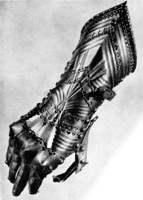Gauntlet
Origin
Middle English, from Middle French gantelet, diminutive of gant glove, from Old French, of Germanic origin; akin to Middle Dutch want glove, Old Norse vǫttr
Definitions
- 1: a glove worn with medieval armor to protect the hand
- 2: any of various protective gloves used especially in industry
- 3: an open challenge (as to combat) —used in phrases like "throw down the gauntlet"
- 4: a dress glove extending above the wrist
Description
Gauntlet is a name for several different styles of glove, particularly those with an extended cuff covering part of the forearm. Gauntlets exist in many forms, ranging from flexible fabric and leather gloves, to mail and fully articulated plate armour.
Historically, gauntlets were used by soldiers and knights. It was considered an important piece of armour, since the hands and arms were particularly vulnerable in hand-to-hand combat. With the rise of easily reloadable and effective firearms, hand-to-hand combat fell into decline along with personal armor, including gauntlets.
Some medieval gauntlets had a built-in knuckle duster. When the hand was bunched into a fist the backhand protection becomes pronounced from the fist just above the knuckles, this allowed the user to utilize the gauntlet as a melee weapon while still protecting the hand from damage when punching. However, against an armed combatant the use of this feature would have been risky so it was very unlikely that a gauntlet would have been used in this way when a more suitable weapon was within reach. But if the user had no other means to defend themselves the tactics they would have employed would be to attempt to surprise the opponent with this inconspicuous attack, possibly by dodging and countering, aiming for exposed areas of flesh such as the face or weak areas of armour, such as under the arm or the groin.
A "Demi-gauntlet" (also called a "demi-gaunt" for short) is a type of plate armour gauntlet that only protects the back of the hand and the wrist; demi-gaunts are worn with gloves made from mail or padded leather. The advantages of the demi-gaunt are that it allows better dexterity and is lighter than a full gauntlet, but the disadvantage is that the fingers are not as well protected.
Idiioms
- "Throw down the gauntlet"
To "throw down the gauntlet" is to issue a challenge. A gauntlet-wearing knight would challenge a fellow knight or enemy to a duel by throwing one of his gauntlets on the ground. The opponent would pick up the gauntlet to accept the challenge. The phrase is associated particularly with the action of the King's Champion, which officer's role was from mediaeval times to act as champion for the King at his coronation, in the unlikely event that someone challenged the new King's title to the throne.
- "Run the gauntlet"
"Running the gauntlet" was a military punishment where a soldier or sailor had to pass between a double row of comrades armed with cudgels. The expression is now generally used metaphorically. Gauntlet in this context is unrelated to the "protective glove" meaning, but is instead derived from the Swedish gatlopp ("street run"). Because of this difference in the derivation of the word, the expression is sometimes written "running the gantlet".[1]
